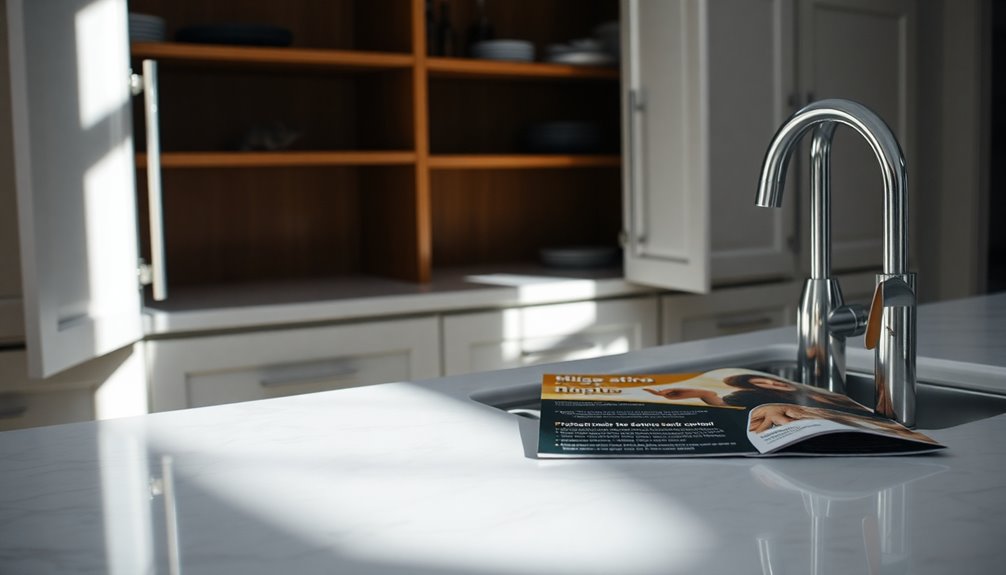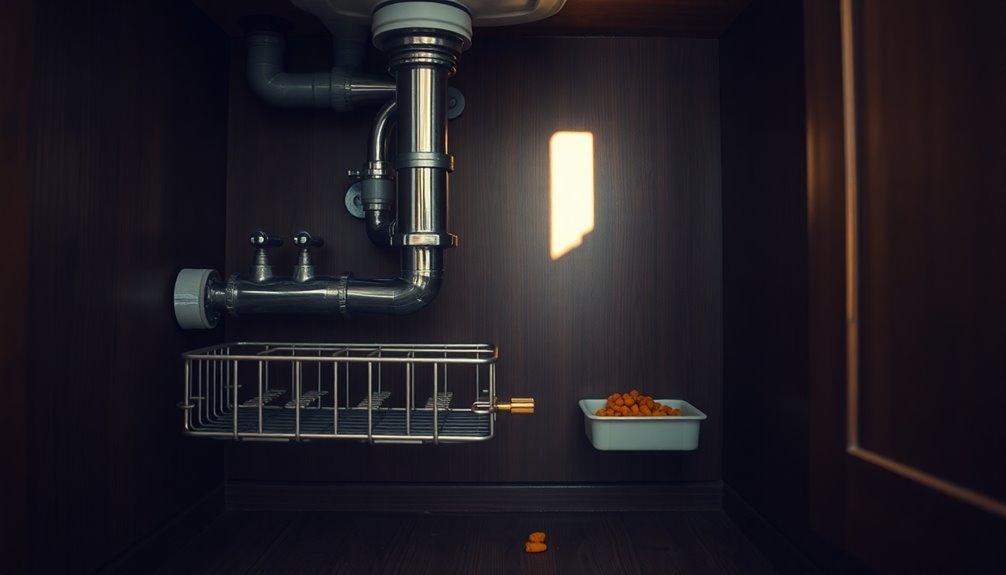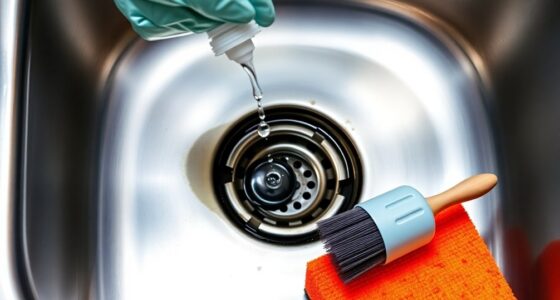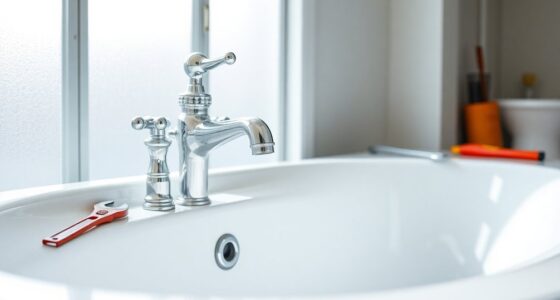To get rid of mice under your kitchen sink, start by cleaning and organizing the area. Remove clutter and store food in airtight containers. Identify and seal any entry points like gaps around pipes. Set up traps where you've found droppings and use natural repellents like peppermint oil or vinegar. Maintain regular inspections to catch any new activity early. Keep following these steps to guarantee your home remains mouse-free and learn more effective strategies.
Key Takeaways
- Clear clutter under the sink to reduce hiding spots and maintain cleanliness, making it less attractive for mice.
- Seal entry points around pipes and gaps with steel wool or expanding foam to prevent mice from entering.
- Set up snap traps and humane live traps in areas where droppings are found to effectively capture mice.
- Regularly clean surfaces and store food in airtight containers to eliminate food sources that attract mice.
- Use natural repellents like peppermint oil and vinegar to deter mice from returning to the area.
Evidence of Mice Under the Sink

When you're suspecting mice under your kitchen sink, look for clear signs that confirm their presence.
First, check for tiny, brown mouse droppings; these are a common indicator of mouse activity.
Next, inspect for gnawed packages or shredded paper, which could be nesting materials.
You should also examine the area for food particles or crumbs that might attract mice, as they're often drawn to easy access to food sources.
Additionally, keep an eye out for any signs of urine stains, which can signal a mouse presence.
Regularly monitor for new droppings and other signs of mouse activity to assess whether the infestation is ongoing.
Identifying these entry points will help you take appropriate action.
Cleaning and Organizing the Area

To keep mice at bay, start by clearing out any clutter under your sink.
Regularly wipe down surfaces and store food and cleaning supplies in airtight containers to maintain food hygiene.
Don't forget to secure your trash bins with tight lids to eliminate potential food sources.
Clear Clutter Regularly
Keeping the area under your kitchen sink tidy is essential in preventing mice from making it their home. To tackle a mouse problem, you should clear clutter regularly, eliminating hiding spots that allow for mouse activity.
Use storage bins for cleaning supplies and guarantee they're tightly sealed to block access to any food sources. Wipe down surfaces to remove food particles or spills that could attract mice, as they're drawn to waste and crumbs.
Dispose of unnecessary items and old packaging that may collect dust, creating a welcoming environment for rodents. Regularly inspect the space to maintain cleanliness and promptly address any signs of mouse activity to prevent future infestations.
Maintain Food Hygiene
A clean and organized space under your kitchen sink goes hand in hand with maintaining food hygiene. Regularly clean the area to eliminate food particles and crumbs that might attract mice.
Make it a habit to wipe down surfaces after use and immediately clean up spills to deny rodents a potential food source. Store all food items in airtight containers to keep them safe from mice and reduce odors that could entice them.
Additionally, remove any clutter and nesting materials from under the sink; this discourages mice from finding hiding spots nearby. Conduct routine inspections to guarantee your kitchen stays mouse-free. Maintaining cleanliness in your kitchen also supports a healthier lifestyle by promoting cleanliness and hygiene.
Secure Trash Bins
One of the most effective ways to deter mice is by securing your trash bins. Verify they've tight-fitting lids to block access to food waste and other attractants that are highly attractive to mice.
Regularly dispose of garbage and clean the bins to eliminate any food residues that might lure them in. Store recyclables in sealed containers until you're ready to take them out, as leftover food particles can also attract rodent activity.
Keep the area around the trash bins free of clutter and debris to reduce hiding spots and promote easier cleaning. For added protection, consider investing in rodent-proof trash cans designed to deter mice and other pests.
These steps can help you maintain control services effectively.
Identifying and Sealing Entry Points

Since mice can squeeze through openings as small as a pencil diameter, it's crucial to thoroughly inspect the area under your kitchen sink for potential entry points.
Check around pipes, vents, and electrical outlets, as these are common gaps. Once identified, seal these entry points using steel wool or wire mesh. For larger openings, apply expanding foam for a more durable seal.
Confirm all gaps are tightly closed to prevent rodent access. Don't forget to regularly check and maintain these seals, as structural vulnerabilities can develop over time, allowing new entry points to emerge.
Finally, make sure doors and windows fit tightly, and consider installing door sweeps to block potential entry at the base of doors.
Setting Up Effective Traps

To effectively catch mice under your kitchen sink, start by setting up traps with tempting bait like peanut butter or chocolate. Here are some steps to follow:
- Identify locations: Place traps where you've found droppings under the kitchen and along common pathways mice are getting through.
- Choose traps: Use a mix of snap traps and humane live traps, as different mice may respond to different types.
- Safety first: Verify traps are out of reach of children and pets to prevent accidents.
- Check regularly: Inspect your traps at least once a day to quickly address captured mice and maintain their effectiveness.
With these tips in mind, you'll increase your chances of successfully catching those pesky mice!
Natural Repellents to Deter Mice

If you want to keep mice away from under your kitchen sink, natural repellents can be a great solution. Consider using peppermint oil, vinegar, or ultrasonic repellents to deter these unwanted guests. Here are some effective options:
| Natural Repellent | Application Method |
|---|---|
| Peppermint Oil | Soak cotton balls and place them around the sink. |
| Vinegar | Mix equal parts vinegar and water in a spray bottle, then apply to entry points. |
| Ultrasonic Repellents | Use devices that emit high-frequency sound waves uncomfortable for rodents. |
Additionally, sprinkling cayenne pepper or using citrus-based cleaners can create an unwelcoming environment for mice. These natural repellents are simple, non-toxic, and can help you maintain a mouse-free kitchen.
Long-Term Prevention Strategies

While natural repellents can help keep mice at bay temporarily, implementing long-term prevention strategies is key to ensuring they don't return under your kitchen sink.
Here are some effective tactics to help you rid of mice:
- Use steel wool to seal gaps and cracks around pipes, vents, and outlets.
- Maintain a clean, clutter-free space under the sink to eliminate nesting spots.
- Store all food items in airtight containers and keep surfaces free of crumbs and spills.
- Schedule periodic inspections, particularly during colder months, to catch leaky pipes or new entry points.
If you're still struggling, consider calling a professional pest control service for additional support.
With these strategies, you'll create a mouse-free kitchen environment!
When to Seek Professional Help

Recognizing the signs of a mouse infestation can be alarming, especially when you notice a rapid increase in droppings or evidence of nesting.
If you've seen droppings and traps are catching mice but new ones keep appearing, it's time to contemplate professional help. This persistent problem suggests there may be hidden entry points that only experts can identify and seal.
Additionally, professionals can conduct a thorough inspection of your home to find breeding sites and potential structural issues contributing to the infestation.
If you have young children or pets, consulting pest control experts guarantees safe and humane methods are used.
Don't hesitate to reach out if DIY control isn't working—it's essential to tackle the issue effectively.
Importance of Regular Inspections

Regular inspections are essential in catching signs of rodent activity before they turn into a bigger problem.
By checking under the sink and other areas frequently, you can quickly address any new entry points or nesting materials.
This proactive approach not only helps prevent infestations but also keeps your home safe and clean.
Early Detection Benefits
By conducting routine inspections, you can spot early signs of mouse activity, like droppings, which enables you to take action before a full infestation develops.
Early detection is essential for preventing costly damage and maintaining a clean kitchen.
Here are some benefits of regular inspections:
- Identify mouse droppings early, allowing for prompt intervention.
- Inspect areas around pipes and vents to seal potential entry points.
- Reduce food sources by keeping the kitchen clean and free of crumbs.
- Implement preventative measures to maintain a mouse-free environment.
Regular Monitoring Importance
Maintaining vigilance in monitoring your kitchen for signs of mouse activity is key to preventing infestations. Regular monitoring enables you to catch new problems early, allowing for swift action. Inspect under the sink and other problem areas for droppings or gnawed materials, which can reveal entry points needing sealing. Document your findings to create a maintenance log that tracks ongoing rodent activity. Additionally, understanding the importance of early detection can help mitigate potential health risks associated with rodent infestations.
| Inspection Action | Frequency |
|---|---|
| Check traps and bait stations | Weekly |
| Inspect under the sink | Bi-weekly |
| Clean and declutter | Monthly |
Community Support and Shared Experiences

When you find mice under your kitchen sink, it's natural to feel anxious, but connecting with others who've faced similar challenges can really ease those worries.
Community support offers reassurance and practical tips that can help you tackle mouse control effectively. Here are some shared experiences to reflect upon:
- Traps – Many recommend placing traps where you see mouse droppings for effective capture.
- Cleaning Surfaces – Regularly clean all surfaces to prevent food attraction.
- Food Storage – Store food properly in sealed containers to deter mice.
- Avoid Poison – Community advice often discourages using poison due to complications in locating deceased mice.
Frequently Asked Questions
How to Get Rid of Mice From Under the Kitchen Sink?
To tackle the issue of mice, start by cleaning the area thoroughly. Remove any food particles, droppings, or nesting materials.
Next, seal any entry points around pipes and gaps with steel wool and caulk.
Set snap traps or humane traps baited with peanut butter or chocolate in active areas. Regularly check the traps and replace bait as needed.
Finally, keep the area dry to eliminate moisture that might attract them.
What Is the Fastest Way to Get Rid of Mice in the Kitchen?
If you want to get rid of mice in your kitchen quickly, start by setting snap traps baited with peanut butter or chocolate in areas where you notice droppings.
Be sure to seal any entry points, like gaps around pipes, with steel or copper wool.
Keep your kitchen clean by wiping surfaces and storing food in airtight containers.
Monitor your traps regularly, and if needed, call a pest control professional for help.
Will Mice Leave on Their Own?
Mice won't just pack their bags and leave; they're like unwelcome guests who've found a cozy spot.
Once they discover a steady food and water source, they'll settle in for the long haul. You can't rely on them to vacate voluntarily.
Instead, you need to take action—seal entry points and eliminate food sources to encourage them to skedaddle.
Otherwise, their population will grow, and the problem will only worsen.
How to Seal Under Sink Pipes so Mice Don't Come Up?
To seal under sink pipes and prevent mice from entering, you'll want to inspect for gaps around the plumbing.
Fill smaller holes with steel wool, which mice can't chew through, and seal it with caulk or expanding foam.
For larger openings, use plywood or hardware cloth, ensuring all edges are caulked tight.
Finally, keep the area clutter-free for easier monitoring of any new gaps or deterioration.
Regular checks will help maintain your defenses.
Conclusion
In the battle against mice under your kitchen sink, you've armed yourself with knowledge and strategies. Like a vigilant knight guarding your castle, sealing entry points and setting traps fortifies your home. With natural repellents and regular inspections, you create an unwelcoming fortress for these unwanted guests. Remember, if the tide of rodents rises too high, don't hesitate to call in the professionals. Together, you can reclaim your space and keep it a haven of comfort and cleanliness.









